Sobek: the favor of the gods cannot be bought, except that…
Blog by: Bibz and Mooh
Aaaahhhh… Autumn. Dead leaves. The rain. The smells. But above all, ESPECIALLY, the beginning of serial cocooning. What, are we the only ones who like to cuddle with inhuman frequency once fall arrives? Cabrel was right, October takes its revenge, but if, like us, you like the fun pastime as a duo, we have a solution for the long gloomy afternoons that herald winter...
So here, for everyone's greatest pleasure, is a charming little game from Bruno Cathala and Sébastien Pauchon: Sobek 2 players (yes, "2 players" is technically part of the name, because it is intended to be a more concentrated reinvention by Sobek, released in 2010). Note that we have not tried the experience of big brother Sobek, only of the diminutive brother – this criticism will therefore only be colored by our appreciation of the latter.
The heart
Sobek is itself a tile drafting and set collection game, with a little bit of “take this!” »… For the most part we seek to amass products from the market, to rally various merchants and other associates, and to sell for the greatest profits (and the greatest pleasure of the eponymous god Sobek, of course). The merchant with the most wealth at the end of the game wins victory and Sobek's favor. But be careful: business sense sometimes (often) means corruption; you will therefore have to try to keep your hands clean. And it's anything but easy...
The style
The first thing we notice, once the game is set up, is the colorful beauty of the game: even in its simplicity, the game offers the eyes bright colors, characters whose personalities shine, and products to sell which, frankly, makes you want to be a merchant yourself... The look, in fact, resembles the child that the characters of Santorini would have had with those of Asterix (take this free mental image, come on). In short: it's pretty, cartoony as hell!

The material is pleasant to handle and does not cause fear of accidental breakage – good, thick, reliable cardboard. The only downside here are the two game aids, which are made of thin cardboard. That said, these are not the elements of the game that we manipulate the most during the game. The Ankh, for its part, is made of good old wood. As it is one of the most important pieces for the progress of the game, this is a wise choice. Not too much risk of breaking it, unless of course your dog puts a paw and/or a tooth on it (no Ankh was injured during the writing of this blog).
The progress of the game
After having designated a player to start, the game takes place (with rare exceptions) always in alternation. On his turn, a player has the choice between three actions:
- Draw a market tile
- Sell a batch of goods (consisting of three or more tiles)
- Play a character tile
The tile draw is the crux of war in Sobek. Not only is this how we collect sets of tiles to sell or characters to play or complete a set, but also, each draw made influences the next player's turn. This is where the aforementioned famous Ankh takes on its full meaning: when you draw a tile, you must place the Ankh token on the empty space, in the direction corresponding to the two darker marks on the tile. drawn (see photos). The Ankh, thus arranged, indicates to the other player the horizontal, vertical or diagonal on which he will be authorized to draw in his turn.

Are you starting to see the importance and deviousness of the draw system? A bit like in Kingdomino (from the same Cathala, by the way), a tile could prove more profitable and useful for us, but choosing it would then allow the opponent to seize another which, given what the latter has harvested since the beginning, would be even more profitable for him... Moreover, making it so that the opponent is unable to choose a tile could quite abruptly end the game (which could be positive , notice, if we are already ahead score-wise).
This is what we liked the most about Sobek. The delicate choice between immediate profit for oneself and immediate profit for the opponent... Well, it is obvious that since the setting up of the board is random, we do not always end up with the same situations - which promotes replayability – but it’s a safe bet that the decisions you will have to make, from one turn to the next, will sometimes be easy and safe, sometimes with serious consequences…
As seen in the photos, the characters on the merchandise tray are face down. This is intentional, because the characters are important tiles that can tilt the course of the game one way or the other. Each character tile has two uses: either it also represents a particular commodity (indicated in the upper left corner) and is used to complete a lot for sale, or it is played during a turn to activate its power single (after which the tile is discarded).
Character powers are varied, and, according to our observations as extraordinary testers, almost always useful. Some allow us to reduce the total of tiles that the other player has in hand, others allow us to remove tiles from our corruption pile (we're coming to that, by the way), still others offer the player the possibility of choose any tile on the board, without accumulating corruption, or moving the Ankh... In short, there is something for everyone, for the Scribe as well as for the High Priest!

Corruption (finally!) accumulates when you “skip” tiles in order to take one in particular. If the tile that interests us, in one of the directions where the Ankh points, is not the first, no problem: we simply draw the one we covet, then we take those that have been skipped and we place them on our pile of corruption. The tiles thus accumulated do not deduct points at the end of the game, but they are intended to reflect the reputation of our merchant: are you an upright and honest merchant, or would you go so far as to scare your rival's camels to achieve your goals? The merchant who has accumulated the least corruption will be awarded a Deben token (and not one of Ben's tokens, from whom one would never dare steal a token) for his honesty, then an additional Deben token for each three points of corruption separating him from the cheat on the other side of the table. (No camels were actually scared during the writing of this blog, but our cat was refused access to the table, by Bastet!)
The other two elements to take into account during the game are canoes and scarabs. Canoes are tokens obtained when you sell a batch of goods. There are only five available each game, but the game contains a good dozen, which promises another layer of replayability. Some canoes hide a score bonus, or a special skill, others still hide corruption – all is not always rosy for the merchants of ancient Egypt!
As for the scarabs, they are strongly reminiscent of the crowns of Kingdomino: if there are any on the tiles of a lot that you sell, they act as a score multiplier. If you sell four fish tiles, which have a total of 3 scarabs, you score 12 points at the end of the game. Very simple, but which still requires a lot of strategy...
When one of the two players no longer has any possible action, therefore the Ankh is not pointing towards any tile, he has no salable lot, nor a character to play, the game ends immediately, and we proceed in the final count. That's when we know the best merchant, the one who has attracted Sobek's favor!

The verdict
Sobek 2 players surprised us. For a long time, we have preferred to play more robust games, which accommodate more than two players. Or, if we're playing a game designed for two players, Uwe Rosenberg's Patchwork is our default choice.
So we were pleasantly surprised! The depth of the decisions made when drawing tiles, the choice of when to sell, when to play a character or when to join a lot... Much more depth than the simplicity of its rules and its recommended age would suggest. At first sight…
That said, this simplicity is still sufficient for the recommended age to actually be appropriate. However, parents know their children better than anyone else, so it's up to them to judge the relevance of introducing them to Sobek earlier than the 10 years on the box!
In the end, for all of his work, Sobek deserves a solid B+. It will certainly remain in our collection for a long time…
If this review interests you, jump on your camel and head immediately to your nearest L'Ace des jeux store!




Leave a comment